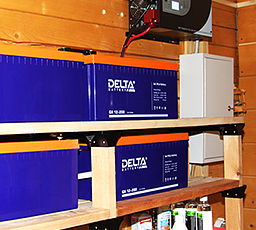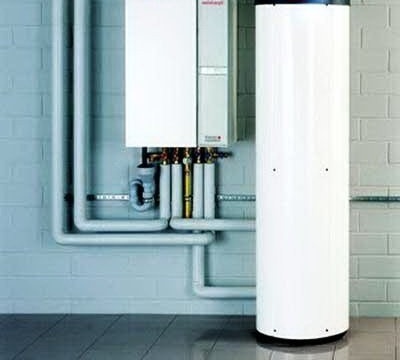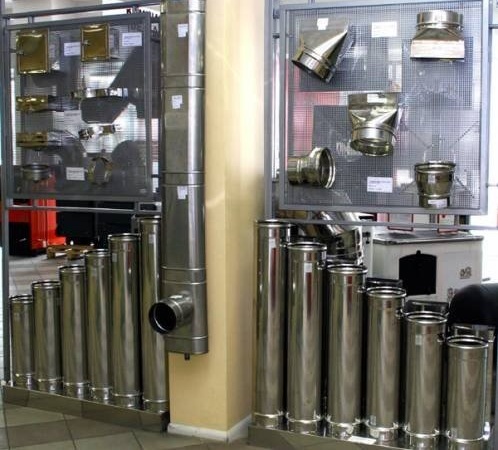How to choose and connect a voltage regulator for a gas heating boiler
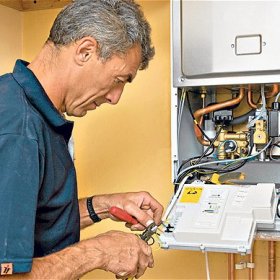
For heating country cottages and residential buildings, autonomous heating systems are very often used. For their arrangement, many choose gas boilers that produce thermal energy for heating the entire building. Such devices are very convenient in operation, they take up little space and are devoid of all the shortcomings of traditional fireplaces and stoves. However, in order for the complex device to serve for a long time and not break, you must strictly follow all recommendations for its operation. In particular, monitor the voltage supplied to it. It is for this that a special device is intended - a voltage stabilizer for a gas boiler.
Content
What kind of device is this - a stabilizer?
The service life of almost any device that runs on electricity, including a standard gas boiler, depends on the stability of the voltage in the network. But at the same time, not every electric grid can boast of constant indicators. Many devices fail only because they got a little more or less than the required 220V. If the device was inexpensive, it is easier to repair or replace it with a new one. But such a device as a gas boiler can be classified as expensive, and its repair is also very expensive.
Voltage drops sharply negatively affect the operation of the automation and control board of the device. It starts to work intermittently, and later simply fails. To avoid this, a voltage stabilizer is needed. The device corrects the voltage and frequency of the current, which makes it possible for all systems to function without overloads and prevents their possible burnout. In addition, boilers that are connected through a stabilizer operate in the most economical mode of energy consumption, and this reduces energy costs.
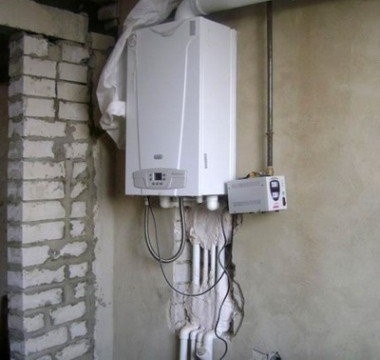
The voltage stabilizer connected to the gas boiler corrects the voltage and frequency of the current, allowing the equipment to work without overloads and protecting it from burnout
Types of stabilizers according to the principle of action
Several types of stabilizers are available. Consider the most popular modifications.
Type # 1 - Electromechanical
Devices with a collector brush that regulates the supply of voltage. Significant advantages of such devices are:
- Wide voltage range and overload resistance.
- High accuracy with a possible deviation from the nominal value within 3%.
- Sufficiently long life.It depends on the performance of the graphite finger in the slip ring system.
The disadvantages of the device include:
- Sensitivity to low temperatures. It cannot be used in cold rooms.
- The current collector brush requires regular replacement, on average once every 3-5 years.
- Low response speed.
- Noise from the engine while the brush moves.
- Carbonization of dust entering the device.
- Possibility of creating an open spark when opening / closing a contact.
The latter circumstance makes it extremely undesirable to use electromechanical stabilizers for installation with a gas boiler. Given that the heater is among the explosive, it is better not to risk life and health, but to install devices of a different type.
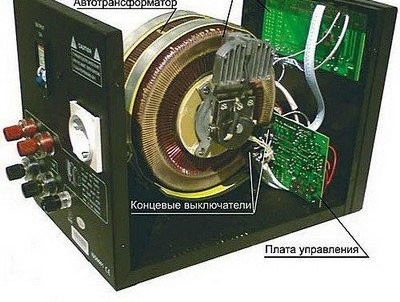
The design of the electromechanical stabilizer assumes the presence of collector brushes. During the operation of the device, an open spark may form, which is extremely dangerous in case of joint installation with a gas boiler
Type # 2 - electronic (relay)
These devices do not have moving parts. Compared favorably with electromechanical ones, they have a sufficiently high response speed in case of voltage drops. The main advantages of the devices include:
- Light weight.
- Compactness.
- Speed of response, which plays an important role in the event of an emergency.
- High resistance to frequent fluctuations in input voltage.
Among the shortcomings, it is necessary to note the blinking of lighting when switching windings and obvious rather loud clicks when switching relay ranges.
In addition, it must be borne in mind that the accuracy of the device depends on the number of keys or steps of the autotransformer. The more of them, the higher the accuracy. However, a large number of windings significantly increases the cost of the device. At the same time, the accuracy of the relay stabilizer for a gas boiler permitted by GOST does not exceed. It is within 5%. In general, such devices are considered the best option in terms of value for money. A small nuance: when buying a relay node, you need to consult the seller about the advisability of using it with a specific boiler model.
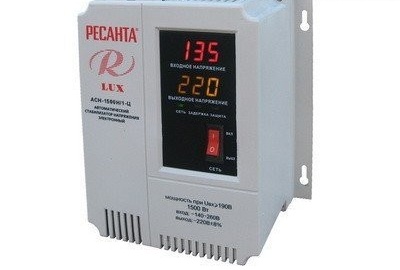
Electronic stabilizers do not have moving parts, therefore they are completely safe for installation with gas boilers. Their main advantages are the high cost of operation and resistance to frequent voltage drops.
Type # 3 - thyristor or triac
The device operates on thyristors - semiconductors made on the basis of a single crystal. Elements work like electronic keys, which gives the stabilizer many advantages:
- Highest response speed.
- Almost unlimited work resource.
- Increased resistance to low and high temperatures.
- Absolutely silent work.
- Resistance to mechanical influences and interferences in electric networks.
- High accuracy.
Disadvantages of thyristor stabilizers are considered to be possible breakdowns of the control board, which requires its complete reconfiguration or replacement. And also a rather high cost of the device itself.

Thyristor voltage stabilizers are characterized by the highest response speed and high resistance to temperature extremes, mechanical stress, network noise. In addition, the resource for their use is practically unlimited
Stabilizer Selection Criteria
When choosing a voltage stabilizer for your gas boiler, you should pay attention to several points.
Parameters of the network to which the device is connected
Each of the models has specific requirements for the voltage supplying the equipment. Most manufacturers indicate in the passport of a gas boiler a narrowed range of its operating voltage. For example, 210-230 V.This is due to the fact that the vast majority of such devices are single-phase devices designed for a standard voltage of 220 V. For them, only 10% of the deviation will be enough for the stabilizer to fail.
Be sure to take into account the fluctuation of the actual voltage that occurs in the network during the day. It is very good to find out the lower and upper limit of oscillations, because if the upper limit is “broken”, the device will immediately de-energize the gas boiler. The selected model of the stabilizer should keep the voltage within strictly specified limits, taking into account the allowed tolerance.
Load value
For the correct operation of the device, it is necessary to determine whether it can cope with the expected load. A low-power model simply can not withstand constant overloads. Buying an overly powerful device is a waste of money. First of all, it is necessary to determine the power consumed by the gas boiler. You can see it in the passport of the device.
Here you need to be very careful and not confuse thermal and electrical power. In this case, you need an electric or input. It is indicated in the "Characteristics" section with numbers with the name W. Whereas in kW thermal power is indicated. The value taken from the passport must be increased by a third. This will be the necessary margin for the correct operation of the device.
If it is planned to connect not only the boiler, but also the pump to one stabilizer, the full load from both devices must be taken into account. It should be noted that experts do not recommend such an installation, but in practice this often happens. An important nuance is to take into account the inrush current of the pump, which in some cases can triple the nominal. To determine the required power of the stabilizer, you must perform the following steps. The pump power is multiplied by three, the boiler power is added to it. The resulting number is multiplied by a factor of 1.3.
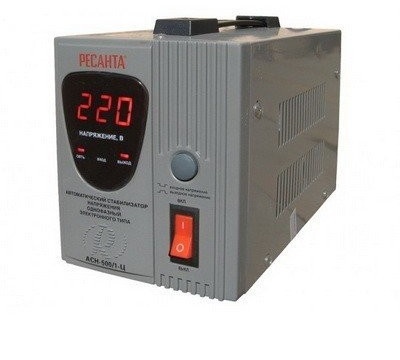
The voltage regulator for a gas boiler in the floor-mounted design is more massive. Such devices are less convenient to use, but their cost is lower
Installation method
Three types of stabilizers are available depending on the mounting method:
- Wall mounted. Small devices that attach directly to the wall.
- Floor standing. Devices intended for installation on any horizontal surface.
- Universal. They can be fixed both on a vertical, and, if necessary, and on a horizontal surface. The most convenient models, because if necessary they can be easily reinstalled.
In general, the stabilizer for the boiler must meet the following requirements:
- Have a power reserve. Most often, a device designed for 250-600 VA will be enough.
- Have protection against overload, short circuit and overheating.
- Have a sinusoidal output voltage, otherwise the pump motor will be damaged.
- Have autostart when power is turned on after shutdown.
- To have the function of protective shutdown in the event of voltage exceeding the safety limits, the so-called voltage “cut-off”.
- Have a grounding terminal.
And a few more tips from practitioners:
- In areas with intensive development and in areas served by old substations, voltage surges often occur. In such conditions, the thyristor stabilizer is the best choice.
- If the passport of the stabilizer model you like indicates that it works in the range of about 200 V, or even more, you should be wary of such a device. Most often, the quality of the output voltage will be insufficient. In this case, special attention should be paid to the country of assembly and manufacturer. His reputation will be a guarantee of quality.
Choosing between floor and wall fixtures, preference should be given to the second option.Such devices significantly save space, in addition, the risk of their accidental mechanical damage is minimal.
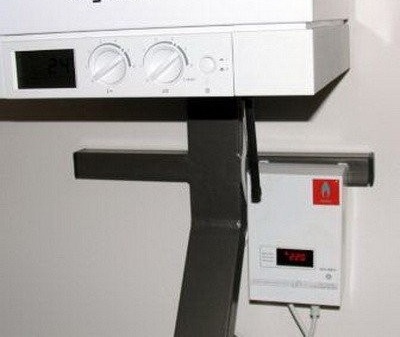
Wall voltage stabilizers are very convenient. The devices are compact, resistant to mechanical damage, but their cost is slightly higher than that of floor-standing
Installation and Connection Technology
Before connecting the stabilizer, you need to choose a suitable place for it. You need to understand that the electrician really does not like damp, so the room where the device will be installed must be dry, without excessive humidity in the air. Most often, valid parameters are indicated in the device manual. If they are not, you can focus on your own feelings. If the room, for example, in the basement, feels excess humidity, it is better not to install equipment here.
The garage will also not be the best place to place the stabilizer. According to the instructions, the device should not be in close proximity to chemically active, combustible and flammable substances. Attic also does not fit. In the warm season, the temperature here often rises very high, which will negatively affect the operation of the device. Another unsuitable place is a niche in the wall or a closed cabinet. The lack of natural air circulation leads to overheating of the equipment.
Actually connecting the stabilizer is very simple. A gas boiler is connected to the equipment, and it simply plugs into the network. If you have to install several single-phase stabilizers at the same time, for example, when three phases enter the room, you can not plug them into a single outlet. Then the first when switching will create network interference, and force the other to switch. This process is practically endless. Thus, for each of the devices a socket should be prepared.
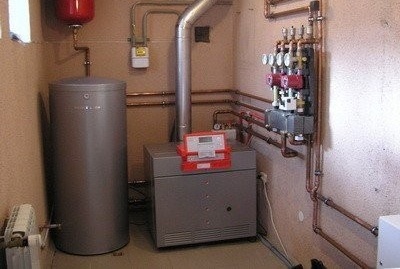
The location for installing the voltage regulator must be selected correctly. The room should not be too humid or hot. In addition, natural air circulation must be ensured, otherwise the device will overheat
Manufacturers of gas boilers warn that all warranty obligations that are given when purchasing equipment will be voided if their operation requirements are not met. In the first place among them most often is the high-quality power supply of the device. You can not underestimate the role of the voltage stabilizer in its provision, therefore, the choice of the device should be approached very responsibly. Properly selected equipment will allow the gas boiler to work for a long time and without interruption in the most economical mode, which will enable its owner to save a decent amount.
